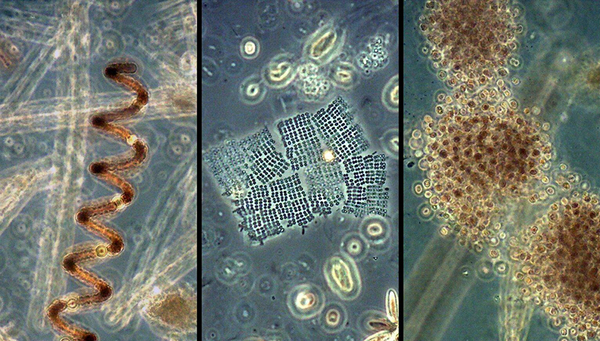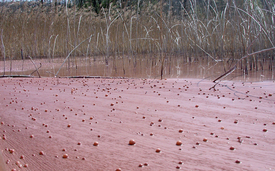Archive detail
The challenges of forecasting algae blooms
August 5, 2021 |
The sky is cloudless, the air humid. People are longing for a refreshing dip in the lake. The water, however, sometimes does not seem so inviting – it might have a greenish or reddish colour – and there could be a layer of scum covering the surface. The cause: a potentially toxic blue-green algae bloom.
Blue-green algae, also called cyanobacteria, are part of the phytoplankton. Phytoplankton are photosynthesising organisms that swim freely in water. They normally provide food and oxygen for other organisms. Usually, the amount of nutrients in the water plays a crucial role in how strong the blue-green algae and other phytoplankton can grow. In a healthy ecosystem, the growth of phytoplankton is controlled by little animals – known as zooplankton – that feed on phytoplankton, as cows feed on grass. Sometimes the blue-green algae, however, produce chemicals that are poisonous to zooplankton. The zooplankton will avoid these blue-green algae, which will then be able to multiply and accumulate in a short period of time, a phenomenon that is called a “bloom”. This development is comparable to plants that grow on a cow pasture, which cows avoid because they are toxic. In such situations, the toxic plants can quickly overgrow the meadow.
Bloom of “Burgundy Blood Algae” (Planktothrix rubescens) in Lake Hallwil, Switzerland.
(Photo: Eawag, Sabine Flury)
Most blooms in lakes and reservoirs are caused by blue-green algae. The toxins produced by these phytoplankton species are not only harmful to zooplankton, but also to people, livestock and pets. For example, people can have skin irritations when swimming during a bloom event. Moreover, the polluted drinking water supply can be harmful to the health of livestock, pets and people. “A large bloom can also cause fishkills,” explains Peter Isles, a former Postdoc at Eawag. When the blue-green algae die, they sink to the bottom of the lake and decay. This decomposition process can often use up all the oxygen in the lake, thus causing a fishkill.
Blooms could become more frequent due to global warming
Calm, warm, nutrient-rich water, together with strong sunlight, can promote the accumulation of phytoplankton. If the conditions are right, blooms can form within days or weeks. “Bloom events are common in Switzerland but harmful blue-green algae blooms do not occur every year or in every lake,” says Francesco Pomati, Group Leader at Eawag. “However, they could become more frequent due to global warming”. To safeguard people’s health and to limit the economic harm caused by poisoned cattle and contaminated drinking water, the monitoring of lakes is important. The researchers do so for e.g. Lake Greifen using Aquascope (Link zu: ), currently the most modern real-time observation platform in the world. Besides tracking the common physical and chemical water parameters, underwater cameras that have a very high temporal resolution also monitor the phytoplankton and zooplankton at a very fine time resolution. “At the moment, we can observe that there are already a lot of potentially toxin-producing blue-green algae in Lake Greifen. If we get a longer warm period in the near future, we could probably expect a harmful bloom”, explains Pomati.
In Lake Greifen, Pomat’s team use an underwater camera to monitor blue-green algae and other phytoplankton species.
Watch the video on Youtube.
With the support of a prestigious Sinergia Grant in the amount of 1.8 million Swiss francs from the Swiss National Science Foundation, Pomati and his collaborators are planning to further study toxic algae species. More specifically, they intend to manually collect genetic data which gives information about whether a species contains the “toxin gene” or not. Together with data captured at high frequency with the automated system on grazers and the environment, they plan to study the dynamics of the toxic blue-green algae populations.
Help from the population is welcome
Additionally, the researchers are testing an already existing mobile phone application together with an easy-to-handle “camera system” (PlanktoScope), both of which could be used by citizen scientists. With such means, everybody that has an interest can contribute to early warnings of algae blooms. By taking these steps, Pomati and colleagues also hope to receive Swiss-wide real-time data on phytoplankton species and amounts and decrease the time gaps in data collection.
Standardisation is essential
Good monitoring tools with high frequency of data collection are not the only challenge, however, when it comes to safeguarding people from hazardous cyanobacteria blooms. Modeling and forecasting such events are just as important. One crucial aspect of a good forecasting model is a standardised definition of a bloom event. Yet, this was missing in the past. “Although there are many definitions of blooms, each of them is different and tailored to a specific application”, explain Isles and Pomati in their new article, published in the renowned scientific journal Frontiers in Ecology and the Environment. In it, they propose a standardised definition for a bloom event that, in contrast to other definitions, is not based on a threshold value for the biomass concentration, but rather refers to the growth and loss processes of phytoplankton.
Besides the improvements to data collection and standardisation of the definition of an algae bloom, Pomati and his team are also currently working with several cantonal authorities to devise a method on how best to respond to algae blooms. In the process, they are testing and standardising several methods and early warning systems. Eventually, this will all lead to better protection of people and livestock and decreases in economic harm caused by algae blooms.
Cover picture: Eawag


